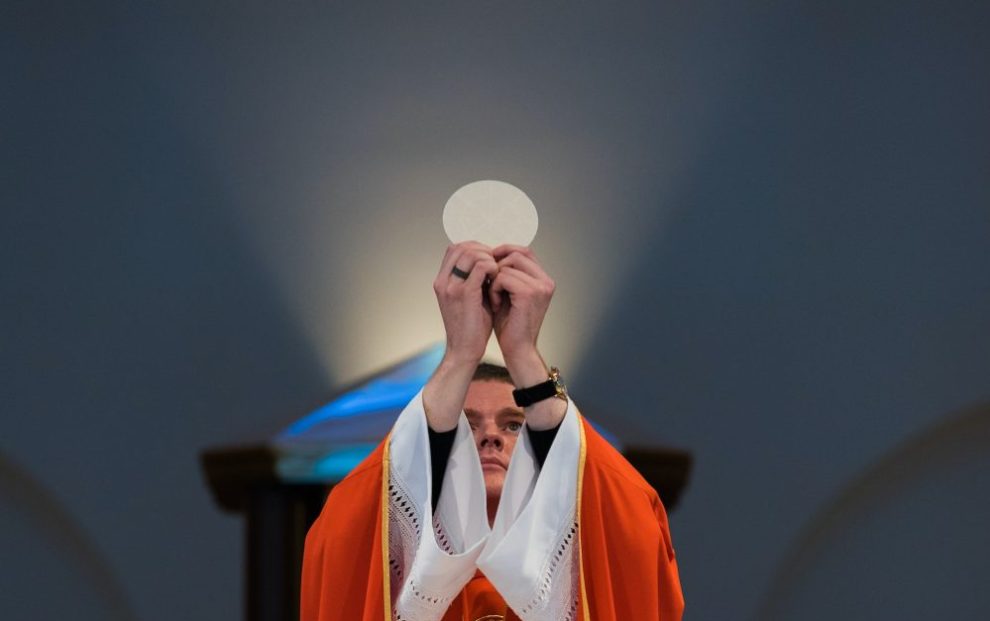The gap between devotees of the Traditional Latin Mass (TLM) and those who prefer the Novus Ordo (“new order”) has measurably widened over the past two years. What many in the church need to realize is that everyone loses in a liturgical battle.
Catholic liturgy, whether the TLM or the Novus Ordo, centers on the celebration of the Eucharist. At Mass, Catholics receiving the Eucharist receive communion. However, communion presupposes unity, and if there is disunity at the center of the liturgy, regardless of which liturgy is being elevated or demoted, this division thwarts the aim of unity, thus preventing it from truly being the body of Christ.
Some may object to this thesis, countering that there is a need to call out liturgical abuses and ideologies that attack the validity of the Second Vatican Council and the present pontiff. While this argument is valid, some solidify these positions into graven idols and refuse to go beyond them to see and love the other as God does.
This is not intended to be an oversimplified “both sides” exhortation, but the division itself is harmful and leads us away from God. Instead of pointing fingers, we need the humility to step back and find the path toward God, which is inseparable from the path toward unity among the body of Christ. How can we work to restore unity in the liturgy and thereby participate in faithful worship that glorifies the body of Christ rather than tears it apart?
I offer three ways the liturgy itself can restore the intended unity in our communal worship.
Reconciliation
While Mass is the celebration of the Eucharist, the liturgy also calls for reconciliation.
While not the formal act of confession and absolution, the penitential act invokes a reflection on our sins and the prayers of the church to overcome sin. Moreover, the Kyrie is included in this act, calling on the mercy of Christ to bring healing from the wounds of sin and division.
The sacrament of reconciliation both promotes and restores unity. This is an important consideration amid the liturgical disunity in the church. The liturgy is a place for communal healing amid communal worship. Not only a place for recalling personal brokenness, this act done in communion with the congregation becomes a divine plea for communal reconciliation.
This is further substantiated in the latter part of the Mass. The Lord’s Prayer calls on us to forgive others as we have been forgiven. This is further memorialized in the sign of peace. Both this and the Lord’s Prayer precede the reception of the Eucharist, signifying that communion with the Lord should not be received until there is reconciliation among the faithful.
Interestingly in the Syro-Malabar liturgy, the sign of peace comes before the Lord’s Prayer, further illustrating the importance of communal reconciliation before receiving the Eucharist.
Liturgical divisiveness misses the purpose of the liturgy. Receiving communion without interpersonal communion is empty and, from the standpoint of interior disposition, likely invalid. We eat and drink of the Lord’s passion unworthily when we do so like the Pharisee looking down on the tax collector (Luke 18:9–14). What brings us to worship worthily is, rather, to recognize how we have judged the other for one’s liturgical preferences and, like the tax collector, approach Christ with conviction, pleading Kyrie eleison (“Lord, have mercy”).
The liturgy is thus a place to experience conversion and reconciliation as well as to greet the one who might not be present at your liturgy with the sign of peace. Whether one is at a TLM or a youth Mass, the same God offers Godself fully to the congregation.
Kenosis
St. Paul reflects on Christ as one who “emptied himself” (Phil. 2:7), or kenosis (κένωσις).
At Mass, we receive God who emptied Godself not only by becoming human but by taking on the form of bread and wine. If the liturgy is a celebration of communion with Christ, received through the kenosis of Christ, then we too are called to kenosis, this Spirit-led self-emptying of all that obstructs our unity with God and one another. The graven idols of our liturgical ideals are among that which we must surrender to experience true communion.
Again, while we believe we are doing the right thing by calling out liturgical errors (and to some extent we are right), becoming the liturgy police prevents us from receiving the grace of humility and vulnerability to see God with purity of heart (Matt. 5:8). Hence, our self-emptying includes surrendering our notions of God and what we think is pleasing to God.
Kenosis has a further benefit. Self-emptying is humbling and teaches us to listen and receive rather than reject and condemn. As I wrote in January 2022, God calls us to self-emptying love toward all people, particularly those with whom we disagree. Through kenosis, we surrender our positions so that we can see the one we disagree with as a child of God, not an enemy to be defeated. When we surrender our liturgical idols, we become “better disposed to participate in true worship of the Trinity by imitating the economy of self-emptying love toward those who are our ideological enemies.”
Following the path of Christ, let us empty ourselves completely, especially our notions of how God ought to be worshipped, so that we may worship God as God desires—a participation in trinitarian love.
Trinitarian communion
Receiving communion at Mass encourages us toward greater communion within the body of Christ and an imitation of the Trinity.
Andrei Rublev’s famous icon attempts to capture trinitarian communion. In the icon, the Trinity sits equidistantly in a circular fashion at a table with a chalice bowl at the center. The circle denotes infinite connectivity and unity without distinct sides. The chalice bowl symbolizes communion and love, as the divine persons experience a communion of unending love rooted in total unity.
Our liturgical dispositions must imitate this communion of sharing, of giving and receiving without sides or power differentials. This communion transcends languages, styles, and forms. Liturgical disputes such as organs versus guitars are not of concern. Rather, there is a total and reciprocal acceptance of the other.
When we permit divine love to inundate our hearts and share this with one another, we realize the insignificant of these liturgical disagreements. They are harmful distractions that prevent us from entering trinitarian communion. And if it does not lead us to experience this divine communion that gratuitously offers divine love, our liturgical worship is in vain.
The communion of divine love can heal the wounds of division in the church’s liturgical factions if we are open to this. But healing will not happen without the Spirit’s conviction that the division is harmful and that reconciliation is necessary, if we are to receive communion at Mass with integrity. While this does not invalidate critiquing liturgical abuses, we are called to imitate Christ by transcending factions and being transformed by the communion the Trinity offers us.
By the grace of God, let us receive the gift of conversion, put aside our liturgical idols, embrace kenosis, and work toward a liturgical communion that leads us to trinitarian communion.
Image: Unsplash/Josh Applegate












Add comment